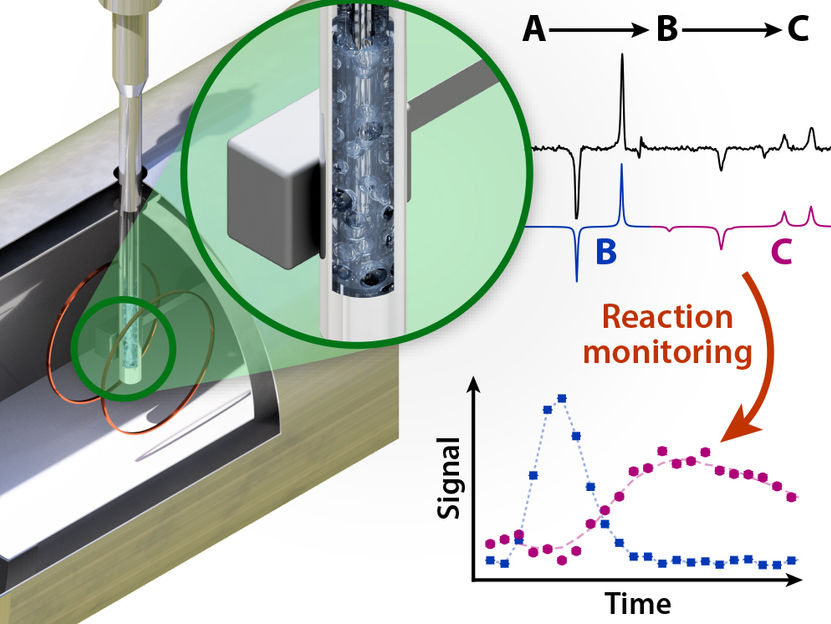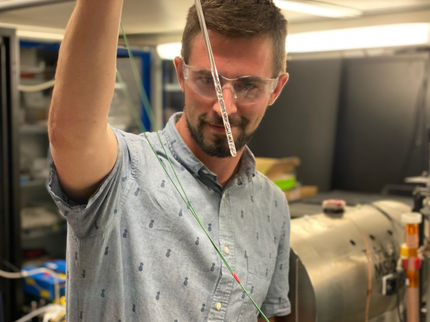New NMR method enables monitoring of chemical reactions in metal containers
Analysis of heterogeneous samples in metal containers using zero- to ultralow-field NMR spectroscopy
Nuclear magnetic resonance (NMR) is employed in a wide range of applications. In chemistry, nuclear magnetic resonance spectroscopy is in standard use for the purposes of analysis, while in the medical field, magnetic resonance imaging (MRI) is used to see structures and metabolism in the body. Scientists at Johannes Gutenberg University Mainz (JGU) and the Helmholtz Institute Mainz (HIM), working in collaboration with visiting researchers from Novosibirsk in Russia, have developed a new method of observing chemical reactions. For this purpose they use NMR spectroscopy, but with an unusual twist: There is no magnetic field. "This technique has two advantages. For a start, we are able to analyze samples in metal containers and, at the same time, we can examine more complex substances made up of different types of components," said Professor Dmitry Budker, head of the Mainz-based group. "We think our concept could be extremely useful when it comes to practical applications."

Chemical reaction monitoring via zero-field nuclear magnetic resonance (NMR): A sequential hydrogenation reaction (A->B->C) is initiated inside a metal reactor inserted into a magnetically shielded enclosure. The NMR spectrum of the heterogeneous (gas/liquid) reaction is recorded with an atomic magnetometer positioned next to the reactor. Analysis of the spectra acquired during the course of the reaction reveals the changing concentrations of compounds B and C.
© John W. Blanchard
As a chemical technique, NMR spectroscopy is used to analyze the composition of substances and to determine their structures. High-field NMR is frequently used, which allows the nondestructive examination of samples. However, this method cannot be used to observe chemical reactions in metal containers because the metal acts as a shield, preventing penetration of the relatively high frequencies. For this reason, NMR sample containers are typically made of glass, quartz, plastic, or ceramic. Furthermore, high-field NMR spectra of heterogeneous samples containing more than one component tend to be poor. There are more advanced concepts but these often have the drawback that they do not make in situ monitoring of reactions possible.
Use of zero- to ultralow-field magnetic resonance proposed as a solution
The team led by Professor Dmitry Budker has thus proposed the use of zero- to ultralow-field nuclear magnetic resonance, ZULF NMR for short, in order to circumvent the problems. In this case, due to the absence of a strong external magnetic field, a metal container will not have a screening effect. The research group used a titanium test tube and a conventional glass NMR test tube for comparison in their experiments. In each case, para-enriched hydrogen gas was bubbled into a liquid to initiate a reaction between its molecules and the hydrogen.
The results showed that the reaction in the titanium tube could be readily monitored using ZULF NMR. It was possible to observe the kinetics of the ongoing reaction with high spectroscopic resolution while continually bubbling parahydrogen gas. "We anticipate that ZULF NMR will find application in the field of catalysis for operando and in situ reaction monitoring as well as in the study of chemical reaction mechanisms under realistic conditions," write the researchers in their article published in the scientific journal Angewandte Chemie International Edition.
Three researchers from the International Tomography Center in Novosibirsk were also involved in the project, namely Professor Igor V. Koptyug, a visiting scholar at HIM in Mainz, Dudari B. Burueva, a doctoral candidate of Koptyug who was also a visiting scholar and a joint first author of the now published study, and Dr. Kirill V. Kovtunov. "Sadly, our colleague Kirill Kovtunov passed away during the preparation of the manuscript for this publication. His contributions were very important to us," acknowledged Professor Dmitry Budker. Furthermore, a group of young scientists from HIM and JGU collaborated in the research project, namely joint first author Dr. James Eills, and Dr. John W. Blanchard, along with doctoral candidates Antoine Garcon and Román Picazo Frutos.
Original publication
Other news from the department science
Most read news
More news from our other portals
See the theme worlds for related content
Topic World Spectroscopy
Investigation with spectroscopy gives us unique insights into the composition and structure of materials. From UV-Vis spectroscopy to infrared and Raman spectroscopy to fluorescence and atomic absorption spectroscopy, spectroscopy offers us a wide range of analytical techniques to precisely characterize substances. Immerse yourself in the fascinating world of spectroscopy!

Topic World Spectroscopy
Investigation with spectroscopy gives us unique insights into the composition and structure of materials. From UV-Vis spectroscopy to infrared and Raman spectroscopy to fluorescence and atomic absorption spectroscopy, spectroscopy offers us a wide range of analytical techniques to precisely characterize substances. Immerse yourself in the fascinating world of spectroscopy!



















































